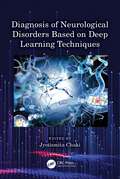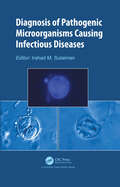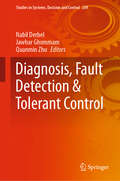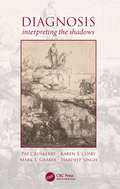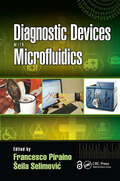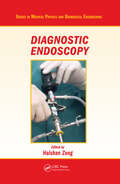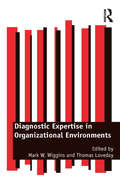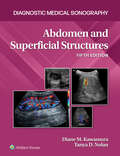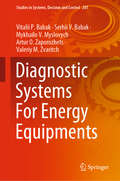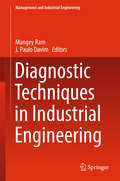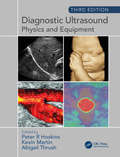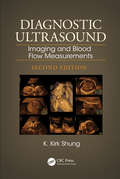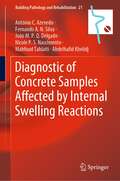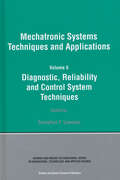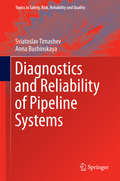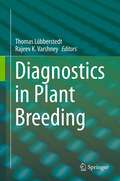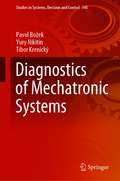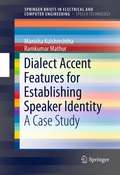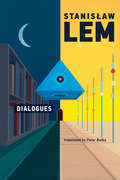- Table View
- List View
Diagnosis of Neurological Disorders Based on Deep Learning Techniques
by Jyotismita ChakiThis book is based on deep learning approaches used for the diagnosis of neurological disorders, including basics of deep learning algorithms using diagrams, data tables, and practical examples, for diagnosis of neurodegenerative and neurodevelopmental disorders. It includes application of feed-forward neural networks, deep generative models, convolutional neural networks, graph convolutional networks, and recurrent neural networks in the field of diagnosis of neurological disorders. Along with this, data preprocessing including scaling, correction, trimming, and normalization is also included. Offers a detailed description of the deep learning approaches used for the diagnosis of neurological disorders. Demonstrates concepts of deep learning algorithms using diagrams, data tables, and examples for the diagnosis of neurodegenerative, neurodevelopmental, and psychiatric disorders. Helps build, train, and deploy different types of deep architectures for diagnosis. Explores data preprocessing techniques involved in diagnosis. Includes real-time case studies and examples. This book is aimed at graduate students and researchers in biomedical imaging and machine learning.
Diagnosis of Pathogenic Microorganisms Causing Infectious Diseases
by Irshad M. SulaimanInfectious diseases are caused by the pathogenic microbial organisms. These microbes can multiply and can cause an infection, once they enter the body. Infectious diseases are transmissible, and may cause mild to life-threatening illnesses. It can be airborne, waterborne, foodborne, and soilborne. It can be spread through direct contact (human to human, animal to human). It has also been one of the leading causes of human deaths. Therefore, there is a need to have rapid diagnostic methods to prevent and control these diseases. This book titled “Diagnosis of Pathogenic Microorganisms Causing Infectious Diseases” will help the scientific community to understand the transmission dynamics of some infectious diseases of public health importance.
Diagnosis, Fault Detection & Tolerant Control (Studies in Systems, Decision and Control #269)
by Quanmin Zhu Nabil Derbel Jawhar GhommamThis book focuses on unhealthy cyber-physical systems. Consisting of 14 chapters, it discusses recognizing the beginning of the fault, diagnosing the appearance of the fault, and stopping the system or switching to a special control mode known as fault-tolerant control. Each chapter includes the background, motivation, quantitative development (equations), and case studies/illustration/tutorial (simulations, experiences, curves, tables, etc.). Readers can easily tailor the techniques presented to accommodate their ad hoc applications.
Diagnosis: Interpreting the Shadows
by Pat Croskerry Karen Cosby Mark L. Graber Hardeep SinghDespite diagnosis being the key feature of a physician's clinical performance, this is the first book that deals specifically with the topic. In recent years, however, considerable interest has been shown in this area and significant developments have occurred in two main areas: a) an awareness and increasing understanding of the critical role of clinical decision making in the process of diagnosis, and of the multiple factors that impact it, and b) a similar appreciation of the role of the healthcare system in supporting clinicians in their efforts to make accurate diagnoses. <P><P> Although medicine has seen major gains in knowledge and technology over the last few decades, there is a consensus that the diagnostic failure rate remains in the order of 10-15%. This book provides an overview of the major issues in this area, in particular focusing on where the diagnostic process fails, and where improvements might be made.
Diagnostic Devices with Microfluidics (Devices, Circuits, and Systems)
by Francesco Piraino Šeila SelimovićThis book provides a current view of the research and commercial landscape of diagnostics devices, particularly those that utilize microscale technologies, intended for both patient and laboratory use. Common diagnostic devices that are based on microfluidic principles include glucose sensors for diabetic patients and over-the-counter pregnancy tests. Other diagnostic devices are being developed to quickly test a patient for bacterial and viral infections, and other diseases. The chapters, written by experts from around the world, discuss how to fabricate, apply, and market microfluidic diagnostic chips – for lab and at-home use. Most importantly, the book also contains a discussion of topics relevant to the private sector, including patient-focused, market-oriented development of diagnostics devices. <P><P>Chapter 9 of this book is freely available as a downloadable Open Access PDF under a CC-BY 3.0 license. https://s3-us-west-2.amazonaws.com/tandfbis/rt-files/docs/Open+Access+Chapters/9781498772938_oachapter9.pdf
Diagnostic Endoscopy (Series in Medical Physics and Biomedical Engineering)
by Haishan ZengCombining a professional development course on diagnostic endoscopy from SPIE (the international society advancing light-based research) and the authors' graduate course on biomedical optics, this work is written for researchers in medical optics and biomedical engineering as well as graduate medical optics students. It uses extensive examples/case
Diagnostic Expertise in Organizational Environments
by Mark W. Wiggins Thomas LovedayDiagnostic Expertise in Organizational Environments provides a state-of-the-art foundation for a new paradigm in expertise research and practice. Skilled diagnosis is essential for accurate and efficient performance across a range of organizational contexts, including aviation, finance, rail, forensic investigation, firefighting, and medicine. However, it is also a complex process, subject to the abilities and experience of individual operators, the culture and practices of organizations, the relationships between operators, and the availability and usefulness of technology. As a consequence, diagnostic skills can be difficult to learn, maintain, and evaluate. This volume is a comprehensive approach that examines diagnostic expertise at the level of the individual practitioner, in the social context, and at the organizational level. The chapter authors comprise both academics and highly skilled practitioners so that there is a clear transition from understanding the problem of diagnostic skills to the implementation of solutions, either through redesign, training, and/or selection. It will appeal to those academics and practitioners interested and involved in this field and also prove useful to students of psychology, cognitive science education and/or computer interaction.
Diagnostic Medical Sonography Series: Abdomen and Superficial Structures
by Diane Kawamura Tanya NolanPart of the highly regarded Diagnostic Medical Sonography series, Diane M. Kawamura and Tanya D. Nolan’s Abdomen and Superficial Structures, 5th Edition, thoroughly covers the core content students need to master in today’s rigorous sonography programs. Careful, collaborative editing ensures consistency across all three titles in this series: The Vascular System, Abdomen and Superficial Structures, and Obstetrics and Gynecology, providing the right content at the right level for both students and instructors.
Diagnostic Systems For Energy Equipments (Studies in Systems, Decision and Control #281)
by Vitalii P. Babak Serhii V. Babak Mykhailo V. Myslovych Artur O. Zaporozhets Valeriy M. ZvaritchThis book examines key issues in ensuring the operational reliability of energy facilities. In this regard, it analyzes mathematical models of diagnostic signals that arise during the operation of power equipment; reviews the main findings of research into their characteristics; presents diagnostics methods for selected types of electric power and heat engineering equipment; and covers a range of diagnostic and monitoring systems and devices for power equipment. Given its scope, the book offers a valuable resource for researchers, engineers and specialists, as well as instructors and graduate students at institutions of higher learning.
Diagnostic Techniques in Industrial Engineering
by J. Paulo Davim Mangey RamThis book presents the most important tools, techniques, strategy and diagnostic methods used in industrial engineering. The current widely accepted methods of diagnosis and their properties are discussed. Also, the possible fruitful areas for further research in the field are identified.
Diagnostic Ultrasound, Third Edition: Physics and Equipment
by Peter R Hoskins, Kevin Martin and Abigail ThrushThis popular text provides a comprehensive, yet accessible, introduction to the physics and technology of medical ultrasound, with high quality ultrasound images and diagrams throughout. Covering all aspects of the field at a level that meetings the requirements of accredited sonography courses, it is ideal for both trainee and qualified healthcare professionals practising ultrasound in a clinical setting. Building on the content of previous editions, this third edition provides the latest guidance relating to ultrasound technology, quality assurance and safety and discusses the latest techniques.
Diagnostic Ultrasound: Imaging and Blood Flow Measurements, Second Edition
by K. Kirk ShungOffers an Extensive Discussion on High Frequency UltrasoundBased on a course taught and developed by a foremost expert in diagnostic ultrasound technology, Diagnostic Ultrasound: Imaging and Blood Flow Measurements, Second Edition covers cutting-edge developments, along with the fundamental physics, instrumentation, system architecture, clinical ap
Diagnostic of Concrete Samples Affected by Internal Swelling Reactions (Building Pathology and Rehabilitation #21)
by António C. Azevedo Fernando A.N. Silva João M.P.Q. Delgado Nicole P.S. Souza Mahfoud Tahlaiti Abdelhafid KhelidjThis book offers a complete diagnosis of concrete samples collected from a pile cap block of residential buildings affected by internal swelling reactions. Covering an extensive laboratory campaign to evaluate the transport properties of concrete samples, as well as their physical and chemical composition using advanced techniques to analyse cores extracted from real buildings that have concrete elements affected by internal swelling reactions (ISR). It features several rehabilitation procedures, pile caps repair and rehabilitation design, executed using strengthening procedures to provide the complete restoration of the structural integrity of the element deteriorated. These rehabilitation procedures proved to be a good solution to retrofit pile cap deteriorated by expansions due to internal swelling reactions of concrete. The book also offers a systematic review of the current state of knowledge and it is a valuable resource for scientists, students, and practitioners in various scientific and engineering disciplines, namely, civil and materials engineering, as well as and other interested parties.
Diagnostic, Reliablility and Control Systems
by Cornelius T. LeondesThe technical committee on mechatronics formed by the International Federation for the Theory of Machines and Mechanisms, in Prague, Czech Republic, adopted the following definition for the term: Mechatronics is the synergistic combination of precision mechanical engineering, electronic control and systems thinking in the design products and manufa
Diagnostics and Reliability of Pipeline Systems
by Sviatoslav Timashev Anna BushinskayaThe book contains solutions to fundamental problems which arise due to the logic of development of specific branches of science, which are related to pipeline safety, but mainly are subordinate to the needs of pipeline transportation. The book deploys important but not yet solved aspects of reliability and safety assurance of pipeline systems, which are vital aspects not only for the oil and gas industry and, in general, fuel and energy industries , but also to virtually all contemporary industries and technologies. The volume will be useful to specialists and experts in the field of diagnostics/ inspection, monitoring, reliability and safety of critical infrastructures. First and foremost, it will be useful to the decision making persons --operators of different types of pipelines, pipeline diagnostics/inspection vendors, and designers of in-line -inspection (ILI) tools, industrial and ecological safety specialists, as well as to researchers and graduate students.
Diagnostics in Plant Breeding
by Rajeev Varshney Thomas Lübberstedt"Diagnostics in Plant Breeding" is systematically organizing cutting-edge research reviews on the development and application of molecular tools for the prediction of plant performance. Given its significance for mankind and the available research resources, medical sciences are leading the area of molecular diagnostics, where DNA-based risk assessments for various diseases and biomarkers to determine their onset become increasingly available. So far, most research in plant genomics has been directed towards understanding the molecular basis of biological processes or phenotypic traits. From a plant breeding perspective, however, the main interest is in predicting optimal genotypes based on molecular information for more time- and cost-efficient breeding schemes. It is anticipated that progress in plant genomics and in particular sequence technology made recently will shift the focus from "explanatory" to "predictive" in crop science. This book assembles chapters on all areas relevant to development and application of predictive molecular tools in plant breeding by leading authorties in the respective areas.
Diagnostics of Mechatronic Systems (Studies in Systems, Decision and Control #345)
by Tibor Krenický Pavol Božek Yury NikitinThis book provides novel approach to the diagnosis of complex technical systems that are widely used in various kinds of transportation, energy, metallurgy, metalworking, fuels, mining, chemical, paper industries, etc.Effective diagnostic systems are necessary for the early detection of errors in mechatronic systems, for the organization of maintenance and for the assessment of the performed service quality. Unfortunately, the practical use of AI in the diagnosis of mechatronic systems is still quite limited and the inability to build effective mechatronic systems leads to significant economic losses and dangers. The main aim of this book is to contribute to knowledge within the topic of diagnostics of mechatronic systems by the analysis of the elements reliability characteristics, using methods, models and algorithms for diagnostics and by studying examples of model diagnostic systems using AI methods based on neural networks, fuzzy inference systems and genetic algorithms.
Diagrams and Gestures: Mathematics, Philosophy, and Linguistics (Lecture Notes in Morphogenesis)
by Fernando Zalamea Francesco La Mantia Charles AlunniDrawing a line, and then another, and another. Go back from the lines to the movements they capture and see gestures in them: not spatial displacements, but modes of knowledge that pass through the exercise of the body. Discovering something new in a gesture: the line that contracts into a point or the point that expands into a zone, perhaps sinking into a hole. Thus experiencing a diagram: a becoming other inscribed in the novelty of the gesture and in the changes of the forms it shapes. This and much more is discussed in the essays gathered in Diagrams and Gestures. Resulting from trans-disciplinary work between mathematicians, philosophers, linguists and semioticians, the volume delivers an up-to-date account of the most valuable research on the connections between gesture and diagram. As one of the most important themes in contemporary thought, the study of these connections poses a challenge for the future: to elaborate a theory that is equal to new and stimulating research methodologies. We call this theory a philosophy of diagrammatic gestures.
Dialect Accent Features for Establishing Speaker Identity
by Manisha Kulshreshtha Ramkumar MathurDialect Accent Features for Establishing Speaker Identity: A Case Study discusses the subject of forensic voice identification and speaker profiling. Specifically focusing on speaker profiling and using dialects of the Hindi language, widely used in India, the authors have contributed to the body of research on speaker identification by using accent feature as the discriminating factor. This case study contributes to the understanding of the speaker identification process in a situation where unknown speech samples are in different language/dialect than the recording of a suspect. The authors' data establishes that vowel quality, quantity, intonation and tone of a speaker as compared to Khariboli (standard Hindi) could be the potential features for identification of dialect accent.
Dialogic Collaborative Action Research in Science Education: Collaborative Conversations for Improving Science Teaching and Learning (ISSN)
by Allan Feldman Jawaher Alsultan Katie Laux Molly NationThis engaging and practical book offers science teacher educators and K-12 science teachers alike the tools to engage in a dialogic mode of collaborative action research (D-CAR), a collaborative mode of action research focused on teachers’ experiences with students, reflection upon these experiences, and peer learning.Renowned science educator Allan Feldman and co-authors from across numerous settings in K-12 science education present the theory, methodology, case studies, and practical advice to support the use of D-CAR as a means to enhance teachers’ normal practice and address the problems, dilemmas, and dissonances that science teachers must negotiate as they work to meet the needs of an increasingly diverse student population and engage with complex science teaching challenges that disproportionately affect marginalized students.The book will be of use to science teacher educators, pre-service and in-service science teachers, professional development specialists, or any science educator invested in developing creative, reflective, and thoughtful teachers.
Dialogic Collaborative Action Research in Science Education: Collaborative Conversations for Improving Science Teaching and Learning (Teaching and Learning in Science Series)
by Allan Feldman Jawaher Alsultan Katie Laux Molly NationThis engaging and practical book offers science teacher educators and K-12 science teachers alike the tools to engage in a dialogic mode of collaborative action research (D-CAR), a collaborative mode of action research focused on teachers’ experiences with students, reflection upon these experiences, and peer learning. Renowned science educator Allan Feldman and co-authors from across numerous settings in K-12 science education present the theory, methodology, case studies, and practical advice to support the use of D-CAR as a means to enhance teachers’ normal practice and address the problems, dilemmas, and dissonances that science teachers must negotiate as they work to meet the needs of an increasingly diverse student population and engage with complex science teaching challenges that disproportionately affect marginalized students. The book will be of use to science teacher educators, pre-service and in-service science teachers, professional development specialists, or any science educator invested in developing creative, reflective, and thoughtful teachers.
Dialogic Education: Mastering core concepts through thinking together (Computer-Supported Collaborative Learning Series #7)
by Rupert Wegerif Neil PhillipsonDialogue has long been used in primary classrooms to stimulate thinking, but it is not always easy to unite the creative thinking of good dialogue with the need for children to understand the core concepts behind knowledge-rich subjects. A sound understanding of key concepts is essential to progress through the national curriculum, and assessment of this understanding along with effective feedback is central to good practice. Dialogic Education builds upon decades of practical classroom research to offer a method of teaching that applies the power of dialogue to achieving conceptual mastery. Easy-to-follow template lesson plans and activity ideas are provided, each of which has been tried and tested in classrooms and is known to succeed. Providing a structure for engaging children and creating an environment in which dialogue can flourish, this book is separated into three parts: Establishing a classroom culture of learning; Core concepts across the curriculum; Wider dialogues: Educational adventures in the conversation of mankind. Written to support all those in the field of primary education, this book will be an essential resource for student, trainee and qualified primary teachers interested in the educational importance of dialogue.
Dialogues
by Stanislaw LemThe first English translation of a nonfiction work by Stanisław Lem, which was "conceived under the spell of cybernetics" in 1957 and updated in 1971.In 1957, Stanisław Lem published Dialogues, a book "conceived under the spell of cybernetics," as he wrote in the preface to the second edition. Mimicking the form of Berkeley's Three Dialogues between Hylas and Philonous, Lem's original dialogue was an attempt to unravel the then-novel field of cybernetics. It was a testimony, Lem wrote later, to "the almost limitless cognitive optimism" he felt upon his discovery of cybernetics. This is the first English translation of Lem's Dialogues, including the text of the first edition and the later essays added to the second edition in 1971. For the second edition, Lem chose not to revise the original. Recognizing the naivete of his hopes for cybernetics, he constructed a supplement to the first dialogue, which consists of two critical essays, the first a summary of the evolution of cybernetics, the second a contribution to the cybernetic theory of the "sociopathology of governing," amending the first edition's discussion of the pathology of social regulation; and two previously published articles on related topics. From the vantage point of 1971, Lem observes that original book, begun as a search for methods "that would increase our understanding of both the human and nonhuman worlds," was in the end "an expression of the cognitive curiosity and anxiety of modern thought."
Dialogues in Data Power: Shifting Response-abilities in a Datafied World
by Juliane Jarke and Jo BatesAvailable open access digitally under CC-BY-NC-ND licence. This book presents emerging themes and future directions in the interdisciplinary field of critical data studies, loosely themed around the notion of shifting response-abilities in a datafied world. In each chapter an interdisciplinary group of scholars discuss a specific theme, ranging from questions around data power and the configuring of data subjects to the intersection of technology and the environment. The book is an invaluable dialogue between disciplines that introduces readers to cutting edge arguments within the field. It will be a key resource for scholars and students who require a guide to this rapidly evolving area of research.
Dialogues in Dying
by Connie Wiskin Mageshwaran SivashenmugavelThis is a unique resource to improve this difficult and highly sensitive area of communication, ideal for both individual use and by groups or in teaching. It offers a visual, interactive training experience, linking with supportive care frameworks. It is accompanied bya DVD which contains filmed scenes illustrating a range of challenging dialogues between health workers and a patient and his family through the journey of his terminal illness. Accompanying booklet highlights communication issues with suggested exercises, reflection points and advice. It is available as individual-use-only product for self-reflective learning, or institutional-use product for tutored learning, both priced to give excellent value.
